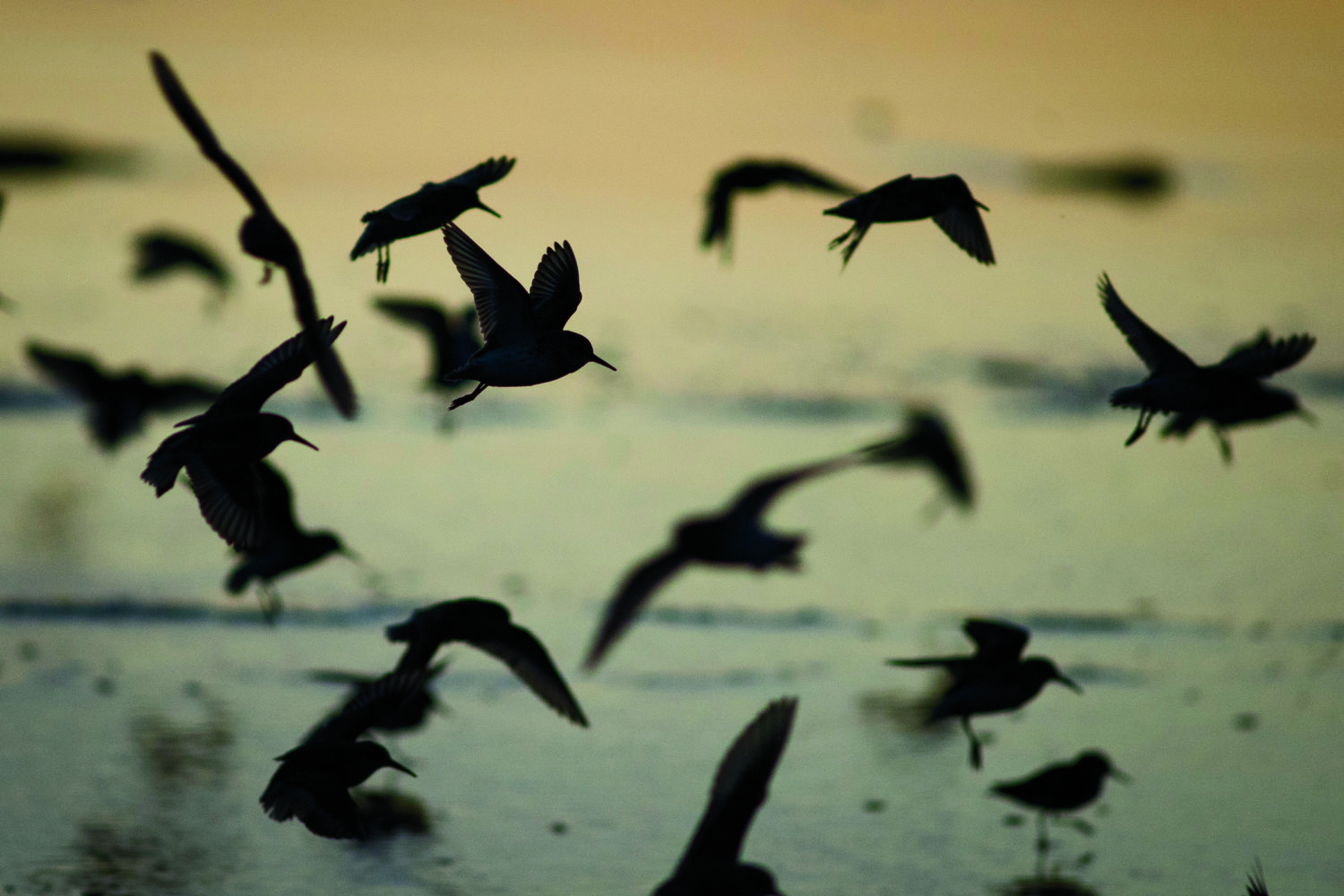
(Aaron Lavinsky | The Daily World)
Shorebirds take flight at sunset along the beach in Ocean Shores on Wednesday, April 30, 2014.
Finding the Coastal Interpretive Center is like finding a beach visitor’s cornucopia of the treasures that inhabit the Central Washington Coast and wash up on its shores.
Rain or shine, inside and out, the Interpretive Center at the very southern end of the Ocean Shores peninsula has become a destination that under one roof preserves the essence of life at the beach like no other destination in the area.
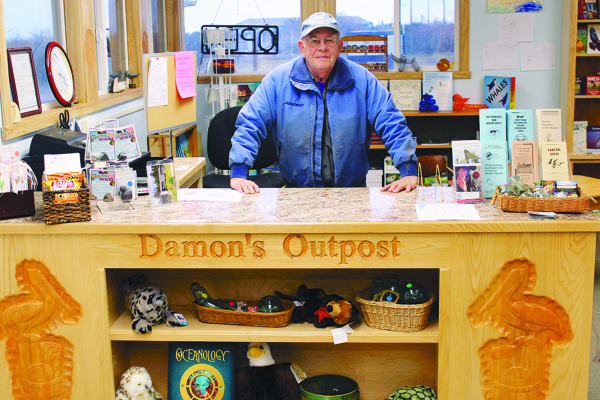
Angelo Bruscas photo/Ocean Shores woodworker Dennis Hogan did all the new additions to Damon’s Outpost book and gift shop and the entrance to the Coastal Interpretive Center.
For birders and wildlife enthusiasts, the Habitat Exhibit area features four main environments of Ocean Shores: the ocean, the near shore and dunes, marshes and waterways, and coastal forests. Exhibits include wildlife and bird displays featuring the species found in the coastal area. A display featuring bird flyway migration information has recently been moved into this area.
For beachcombers, there are collections of glass fishing floats, Japanese tsunami debris, agates galore, along with shells, sand dollars, stones, minerals and numerous artifacts from a history of shipwrecks and settlers.
For kids, there is a hands-on room. “You can open up the drawers there, there’s lots of stuff to look at,” advises Jim Nagan, president of the center board, as a family from Vancouver, B.C., stops by in early January.
For local history buffs, there is a section on the early days of Ocean Shores with celebrities like Pat Boone and Ginny Sims leading development in the 1960s. There is an expanding display on the Quinault Indian Nation and also a garden that includes some of the plants native to the beach area.
Newly renovated, with spectacular woodworking by local volunteer Dennis Hogan, the center is preparing for the spring and summer seasons with an emphasis on becoming a destination that stands on its own merit and is not just an afterthought for visitors who happen to stumble upon it.
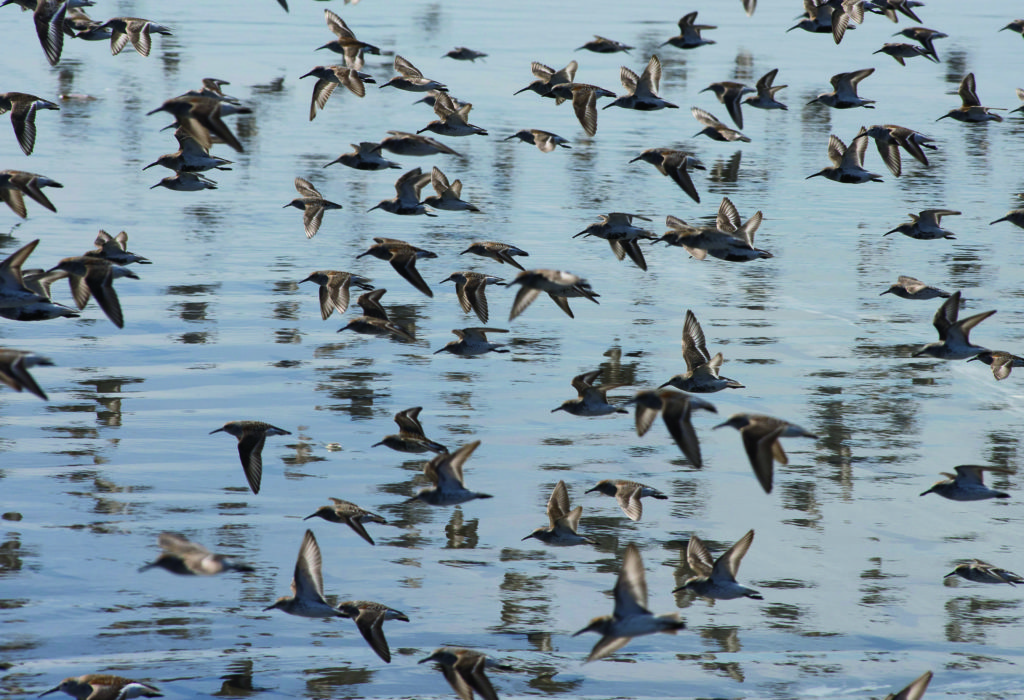
(Aaron Lavinsky | The Daily World)
A flock of shorebirds takes flight along the beach in Moclips in early May.
The biggest hurdle the Interpretive Center might face is the difficulty some visitors have in finding it in the first place. Located by driving Point Brown Avenue to the southern end of Ocean Shores, the center is found by turning on Discovery Avenue at the intersection with Catala. You can’t miss the seahorse or the shipwreck artifacts in front, along with the newly painted whaling harpoon cannon and other displays neatly arranged around the building.
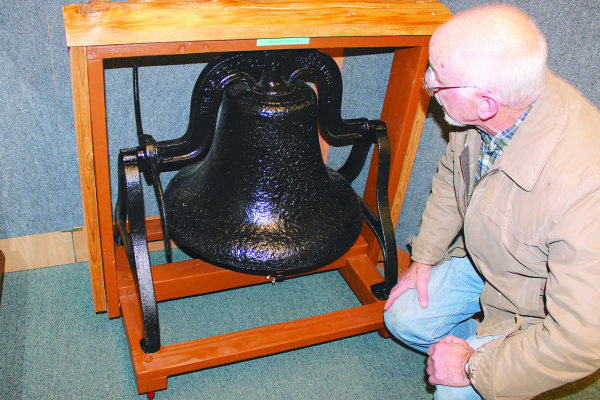
Angelo Bruscas photo/Jerry Mergler, a Coastal Interpretive Center volunteer, inspects the Coast Guard bell he helped to restore. The bell was used to warn the area in the event of a Japanese attack by sea during World War II.
In the past year, the center — a non-profit organization that doesn’t charge an entry fee and relies on contributions and volunteers — was able to renovate its front entry and showcase some of its most valuable features, such as the bookstore, which has one of the best selection of books on coastal and Harbor wildlife, geology, lore and legend. You can even get a rock polisher and stock up on polishing supplies should you want to take beach collecting further.
Grants have come from the Home Depot Community Foundation, the Quinault Indian Nation and the Seabrook Foundation most recently. A $5,000 grant from the Quinault Nation will next allow the center to update all of its cultural exhibits, and the facility is looking for a curator as well. Funds from the city allow the center to now market itself outside of the area and hire a curator.
Nagan notes the center now is involved in much more than just displaying artifacts and treasures from the beach. Most recently, docents have helped identify rare species of sea turtles seen in local waters and have collected evidence of the impacts of ocean warming or of tsunami debris. The center has sponsored a popular annual lecture series, “Glimpses,” which brings regional and local experts into a public forum through winter and early spring.
“I think the additional programs we have started to offer, including the evening lecture series, trying to be more than just a place, that all helps us become part of the community network,” Nagan said of the center’s new push to market itself as a full destination facility.
For the summer months and nicer days ahead, there are now picnic tables set out where families and groups can pack a lunch and enjoy the park-like atmosphere, then take a walk on the interpretive trial through the beach forest. The remodeled Damon’s Outpost Bookstore has books on birds, animals, sea and marine life, Native American culture, history, gardening and recipes. An extensive collection of children’s books fills the corner, dedicated to longtime volunteers Walter and Elone Weed. Gift items include postcards, handmade bookmarks, artwork from local artists, even some authentic glass floats.
Long-term goals are to partner with the National Oceanic and Atmospheric Administration, the Olympic National Marine Sanctuary, as well as other museums in the area such as the Museum of the North Beach in Moclips and the Polson Museum in Hoquiam. The center currently has a seismic monitor that provides earthquake data to a center at Stanford/U.C. Berkeley in California. It also has the most accurate rainfall totals on the North Beach.
To Nagan and the staff, the mission of the center is as clear as a light shined through a pure agate: “The Coastal Interpretive center is to educate the public concerning natural and man-made environments through presentation of the history and ecology of Washington State’s coastal life.”
That motto, Nagan says, tells the whole story of what the center strives to be.
Coastal Interpretive Center
Located: 1033 Catala Ave. SE in Ocean Shores, 360-289-4617
Online: www.interpretivecenter.org
Fall/Winter hours: The center is open to visitors on Saturdays and Sundays from 11 a.m. to 4 p.m.
Spring/Summer hours: In effect from April 1 through the week after Labor Day. The center is open 11 a.m. to 4 p.m. daily.
Admission is FREE
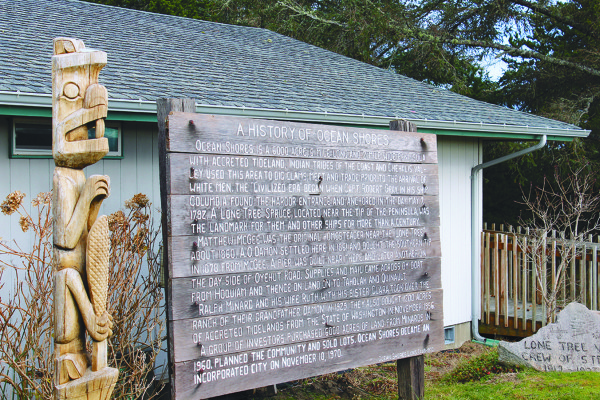
Angelo Bruscas photo/A history of Ocean Shores greets vistors in the yard of the Coastal Interpretive Center.